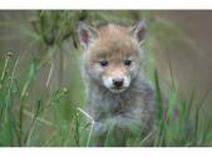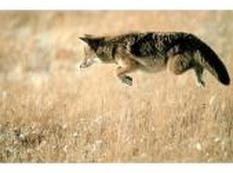Coyotes by Michelle Eckart

Coyote Pup
Coyotes generally mate between February and April. The average litter size is six pups. Females and males will mate for several seasons.
.

Coyotes run with their tails noticeably down
Coyotes are most active at night and generally hunt starting at dusk. Most hunt alone unless they are chasing larger animals such as deer, in which case they will hunt in packs. They are carnivorous and mainly feed on small mammals but sometimes snakes and birds. They also may feed on vegetation, fruits, berries or pet food and garbage that is left out at night.
If you have small to medium pets try to let them out before dark. DO NOT leave them out all night. As you well know by now a coyote will see your smaller pets as a part of the food chain.
1969 coyote populations were confirmed in only 23 rural counties in Georgia. Since then coyotes have now been confirmed in all 159 counties in the state. The spread was partially due to fox hunters that released coyotes for their dogs to hunt (instead of fox), providing training skills for the dogs. Land development has forced them out of their natural habitat into populated areas. Coyotes have flourished due to their amazing ability to adapt to any situation and food source.
Coyotes have a language all their own. Know as the “song dog” they yip, howl, whine and even bark. It is very common for them to communicate to each other with a variety of calls. When hunting alone howling to each other can alert a big kill for the pack or find their way back to the pack. Coyotes play with each other like dogs and playing sounds are yips and barks. They are a pretty organized group even though they generally hunt alone. The happy howl has a playful songlike pitch to it. The word “coyote” derives for the Aztec Indian word coyotl which means “barking dog”.
Coyotes are generally the prime suspect when larger pets or livestock are missing. No one ever thinks or talks about wild dog packs which do hunt together. A wild pack of dogs can take down larger animals where the lone hunters will stick to smaller easier prey such as rabbits, cats, rodents, deer fawn, garbage and pet food.
The majority of coyotes in Georgia are killed by hunters since they are considered non-game animals. This means that they can be hunted year-round with limited restrictions.
There have been only three documented attacks on people by coyotes in the past fifty years, compared to dog bites which happen on a daily basis. Keep in mind that they are as scared of you as you are of them. They are more territorial and aggressive during their breeding season which can pose a possible problem for larger dog breeds. The coyote could feel his mate or pups are at risk.
If you have small to medium pets try to let them out before dark. DO NOT leave them out all night. As you well know by now a coyote will see your smaller pets as a part of the food chain.
1969 coyote populations were confirmed in only 23 rural counties in Georgia. Since then coyotes have now been confirmed in all 159 counties in the state. The spread was partially due to fox hunters that released coyotes for their dogs to hunt (instead of fox), providing training skills for the dogs. Land development has forced them out of their natural habitat into populated areas. Coyotes have flourished due to their amazing ability to adapt to any situation and food source.
Coyotes have a language all their own. Know as the “song dog” they yip, howl, whine and even bark. It is very common for them to communicate to each other with a variety of calls. When hunting alone howling to each other can alert a big kill for the pack or find their way back to the pack. Coyotes play with each other like dogs and playing sounds are yips and barks. They are a pretty organized group even though they generally hunt alone. The happy howl has a playful songlike pitch to it. The word “coyote” derives for the Aztec Indian word coyotl which means “barking dog”.
Coyotes are generally the prime suspect when larger pets or livestock are missing. No one ever thinks or talks about wild dog packs which do hunt together. A wild pack of dogs can take down larger animals where the lone hunters will stick to smaller easier prey such as rabbits, cats, rodents, deer fawn, garbage and pet food.
The majority of coyotes in Georgia are killed by hunters since they are considered non-game animals. This means that they can be hunted year-round with limited restrictions.
There have been only three documented attacks on people by coyotes in the past fifty years, compared to dog bites which happen on a daily basis. Keep in mind that they are as scared of you as you are of them. They are more territorial and aggressive during their breeding season which can pose a possible problem for larger dog breeds. The coyote could feel his mate or pups are at risk.
|
With the increase of coyote sightings all over Georgia people have concerns about their small pets and incidents occurring in their neighborhoods. Fears are at an all time high.
How to identify a Coyote from a dog? 1) Coyotes have Gold/Yellow eye color 2) Triangular Ears 3) Long Bushy Tail 4) Longer than usual Snout and Black Nose 5) Yellowish to Grayish fur on top and White fur on the underside. 6) High on Frame (tall) but Light Build and Weight, about 22 to 40 lbs 7) Coyotes run with their tails down, dogs tail is up and Wolves tail is straight. |
What to do if you encounter a Coyote?
1) Make yourself look as large as you can. 2) Keep eye contact 3) Run and scream (looking large) straight at them – the coyote is going to turn and run away. 4) Spray them with a hose, throw rocks or spray them with mace. 5) DO NOT turn your back and run away this could trigger a flight attack instinct (also common with dogs). |
There are people that have rescued coyote pups and raised them as their pets.
Check out the site The Daily Coyote.
This young lady documents her daily happenings with her coyote - Charlie.
It’s funny this coyote’s best friend is the cat – hum.
Check out the site The Daily Coyote.
This young lady documents her daily happenings with her coyote - Charlie.
It’s funny this coyote’s best friend is the cat – hum.
